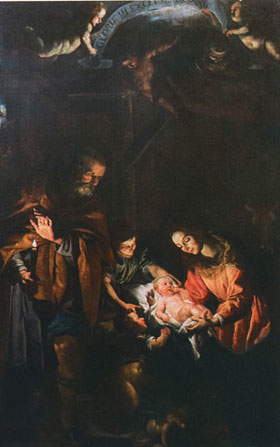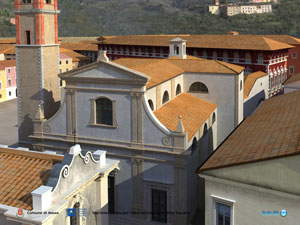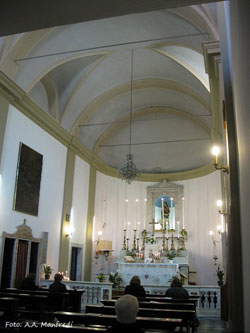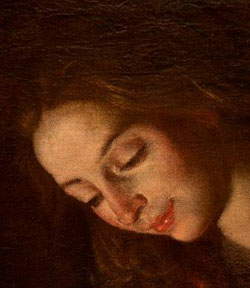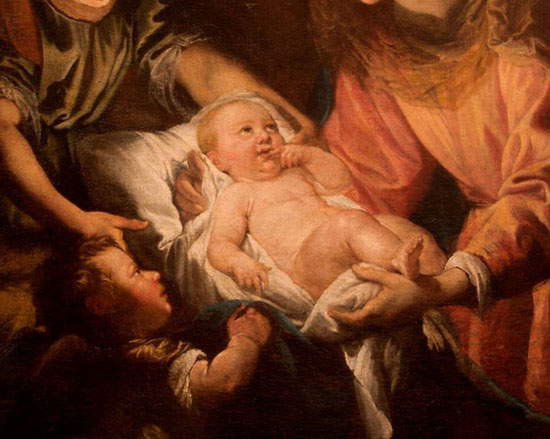by Federico Giannini (Instagram: @federicogiannini1), published on 09/02/2015
Categories: Works and artists
/ Disclaimer
The exhibition telling the story of the Nativity by Nightlight, a beautiful painting from around 1630 attributed to Domenico Fiasella or his workshop, continues in Massa
If you happen to be passing through Massa by March 15, take some time to visit the Diocesan Museum and the exhibition The Nativity by Nightlight. We had already told you about it in our first article written in The Daily Slow, and we are returning to devote a post to the Nativity exhibited in recent months at the Diocesan Museum in Massa to delve into its interesting and I would say even rocambolic history. For this painting, in its nearly four hundred years of life, has undergone several vicissitudes, even tormented ones.
 |
The Nativity attributed to Domenico Fiasella or his workshop; ca. 1630; Massa, Museo Diocesano |
Let us clarify in the meantime that
we do not know who is the author of this painting as dense with lyrical tenderness as it is pregnant with
naturalism. However, the clues that have led
art historians to propose the name of
Domenico Fiasella (or perhaps even that of his workshop) are not few. The swirl of flying angels recurs often in the Ligurian painter’s work, and this one in particular recalls that of the
Martyrdom of St. Barbara in the church of
San Marco al Molo in Genoa. The Madonna’s youthful face with certain hints of sensuality recalls certain saints and Madonnas created around the 1930s (the altarpiece in the church at
Pugliola, a small village in La Spezia located on the hill overlooking
Lerici, is worth mentioning). The ability to harmoniously unite naturalism of Caravaggesque ascendancy and classicism is then the hallmark of Fiasella’s work. Add to this the fact that, in the 1630s, Fiasella began to have relations with the
Cybo Malaspina family of the principality of Massa and Carrara, and the fact that the painting is mentioned as a work of Fiasella’s circle by a scholar of the time,
Giovan Battista Bergamini, and the name of the Sarzanese painter and the date (around 1630) seem the most plausible.
The painting was originally in the
parish church of San Pietro di
Massa, the city’s most important church: it occupied one of the sides of what is now
Piazza Aranci, the one on which the majestic
Ducal Palace stands. In 1807 the church was demolished at the behest of
Felice and Elisa Baciocchi, who wanted to enlarge the square. The liturgical furnishings and works of art of the ancient church were thus dispersed. The latter included our
Nativity, which had been in St. Peter’s since 1633. We know this from documents: in that year new altars were built in the church, including the one that was to house the
Nativity, and which was sponsored by a wealthy citizen of Massa, a certain
Baccio Farsetti. After the almost total collapse of the church in 1671, caused by the fact that the building had been enlarged over the centuries without taking into account the excessive load on the structure, the altar of the
Nativity was moved during the rebuilding work. This led to 1807, the year in which, as mentioned, the church was demolished, not without difficulty since the Baciocchi government could not find anyone in Massa willing to put in the work, such was the attachment the people of Massa had to their church.
Following the dispersal of everything contained within the sacred building, a few years of documentary gaps insist on the
Nativity, whose last notation before dispersal is attributed to the Massese painter
Saverio Salvioni (it was he who described it, shortly before the demolition of the church of San Pietro, as a “nativity by night light”): that is, there are no documents that can tell us with certainty where the painting ended up. To reconstruct the history of these years, therefore, we have to move a few meters from Piazza Aranci, to what was formerly the
convent of the Servants of Mary, just outside the walls of Massa. Following the suppression of the Servite order, which also took place in 1807 during the Napoleonic rule of the Baciocchi, the convent was transformed into a hospital, and after the Restoration, Duchess
Maria Beatrice d’Este, who had recently taken office on the throne of Massa and Carrara, entrusted the management of the hospital structure to the Barnabites. Following the new management, the building underwent modernizations that also affected the adjoining little church of the
Blessed Virgin of Sorrows. Since a number of objects and materials from the old St. Peter’s were used during these works, it is likely that in these years the
Nativity ended up in the little church, where it is first attested in an inventory, drawn up in 1844 by the Jesuits, who succeeded the Barnabites that very year in the management of the hospital. On the occasion of the transfer, the
Nativity had to suffer, unfortunately, cuts on the sides, made in order to adapt the work to its new location: unfortunately, at the time, attention to works of art was not the same as it is today.
This brings us to 1859, the year in which the unification uprisings broke out in Massa, as in other cities in Italy, and the Jesuit fathers had to abandon the structure: following theunification of Italy, the former convent was bought by the Municipality of Massa, which made it the seat of the city court, schools and other activities (even today, some schools have their headquarters in the premises of the former convent). The Nativity remained where it was, although it went through considerable deterioration, so much so that it became necessary to tear down the chapel that housed it, and the work underwent a move inside the small oratory. After World War II, parish priest Angelo Ricci had the small church restored, and on that occasion the painting was sent to the Superintendency for initial restoration: it returned to its home in 1958. The canvas, once again forgotten, was recently transferred to the Diocesan Museum and again restored. The exhibition underway these days was organized precisely after the restoration was completed.
 |
| Detail of the face of the Madonna |
And it is thanks to this latest restoration that it was possible to reconstruct the troubled but at the same time very interesting history of this painting. An example of the great importance of the restoration? The elimination of the repainting from later periods made it possible to bring to light the elements of the painting affected by the curtailments as a result of the displacement: the discovery was decisive for understanding what the steps had been that affected the work, and thus for giving a considerable boost to research on the canvas (as well as for discovering its author). The exhibition, curated by a young art historian,
Andrea Ginocchi, displays a dense series of documents that testify to the work’s vicissitudes: the ancient drawings of the church of San Pietro, the plans of the Servi convent, documents from the Napoleonic era, Angelo Ricci’s notebook, and much more, in a coherent itinerary that, after showing the visitor the
Nativity, accompanies him, following the thread of history, through the events that affected the painting. An appointment, therefore, not to be missed for lovers of art, and also of history. If only to contemplate in silence that Madonna so sweet and graceful in her almost sensual simplicity, or that tenderly illuminated
baby Jesus, or the feast of the fluttering angels, or the natural gesture of St. Joseph repairing, with his hand, the light of the candle.
 |
| Baby Jesus, from the Nativity |
Warning: the translation into English of the original Italian article was created using automatic tools.
We undertake to review all articles, but we do not guarantee the total absence of inaccuracies in the translation due to the program. You can
find the original by clicking on the ITA button. If you find any mistake,please contact us.
